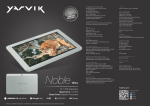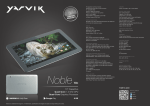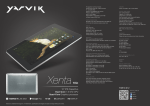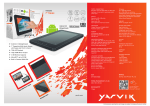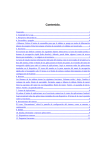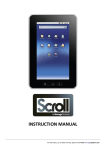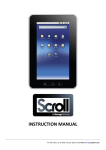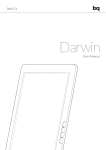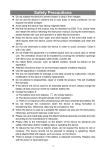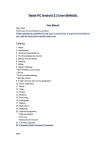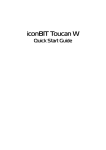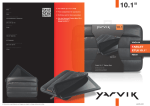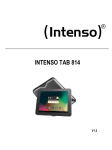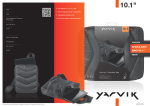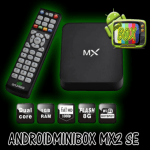Download Preview of “Microsoft Word - TAB250 manual.doc”
Transcript
YARVIK TAB250 INSTRUCTION MANUAL User's Guide Thanks: Dear User Thank you for purchasing our product. These operational guidelines for the user, to ensure you a quick and convenient to use, read the instructions carefully before use. Note: * This product is a high precision electronic products, do not disassemble. * Avoid strong beat, the collision of the product. * Avoid using this product the following conditions: high and low temperature, moisture, dust, magnetic fields strong and long-term exposure to sunlight. * Please use a wet cotton cloth wrung gently wipe the product shell, do not use other chemical cleaning solution. This product should not be dripping or splashing water, so should not be placed near the product category, such as glass filled with a liquid items. * Too long, use the headphone volume is too large may cause permanent hearing damage. * Do not cross the road, driving motor vehicle or bicycle use headphones to avoid traffic accidents. * Please only use permitted batteries, chargers and accessories, use any other type of products would violate the warranty regulations and may be dangerous. * Please follow the relevant local environmental regulations to deal with obsolete machines and accessories. * This product is in the course of any questions, please contact your local dealer or directly with the company's customer service center. * For those because the product is damaged, repair or other causes of memory loss wipe coating, the Company assumes no responsibility, please follow the user manual for standard operation, and timely backups. Package contents: 1 x 7” Tablet 1 x 5V 2A DC charge adapter 1 x Mini USB cable 1 x USB host cable 1 x Instruction manual 1 x Quick installation guide 1 Startup and shutdown * Boot: Press and hold the power button, the system will enter the startup process, as follows: Boot Logo startup … System has been started, are entering the Android system: 2 The system enters the default home interface. *Shutdown: Press the power button, pop-up device options, select Shut Down, as follows: Click OK, you can safely shut down. *Sleep: the machine under normal operating conditions, Short press the power button, Into hibernation, Now, Screen will close. Short press the power button again, Be able to resume normal mode. When the time being use this tablet can enable this feature when, To reduce power consumption. 3 Desktop: System after the completion of normal start, Desktop can see Android2.3(The figure) The default desktop by the: Status Bar, Quick Search Bar, Main menu labels and a number of shortcut icons form. The status bar to display the current system of network status, Battery, Time information. Quick search box for Web search by typing key words. Middle right of the screen the main menu tab stop, Click or drag to the main menu bar to start the default. Bottom of the screen displaying the browser shortcut icon. Button: Android system uses in the course of the keys: Volume keys: the buttons on top Volume +, Volume-achieve changes in the volume. Power key: Press and switch machines. Short press to enter or leave the hibernation. Menu button: Displays the current form of the menu items (if any). Home button: Back to the home screen Return: Return to last interface. Main Menu Operation: Click or drag the main interface of the main menu tab, the main menu will be from right to left (or bottom-first, last), and is as follows: ! 4 In the main menu, the system can be set to run existing applications, install a new application, start the touch calibration, music player, video player, web browsing, games and other operations. System Settings: Click the main menu interface in the "Settings" icon, you can open the system settings interface, as shown below: ! 5 Select the appropriate operation of the relevant items, such as: * Wireless and network * Sound and display * Date and time settings * About Device Etc *Date and time settings: Set interface options "time and date settings options" to enter the date and time settings interface: Can choose to automatical: use the Network Time. Can also select to set the date, select the time zone, set the time, time format, date format and other information. For example, choose to set the date, as follows: ! ! Select +: that the increase of 1 unit, Select -: that the reduction of 1 unit. Also can choose the number, enter the input mode. Directly entering the desired number, then select Done. As follows: 6 ! ! Select "Settings." If you enter the number of legitimate, then the operation is successful, the system will set the option to use the new. *Screen brightness: In the setup interface choose "sound and display settings" to enter the sound and display settings interface, scroll down section, select "Brightness", there are interface: ! ! 7 *Standby screen: Standby screen: the screen automatically locks the delay before. In the setup interface choose "sound and display settings" to enter the sound and display settings interface, scroll down section, select the "standby screen" interface appears, as follows: Note: In the video, the screen auto-standby function does not. ! *Wi-Fi Wireless Connection: Click the main menu "Settings" icon, go to "System Settings" screen, click on "Wireless and network" into the "Wireless and network" setup interface. Click the "WiFi" section to quickly open the Wi-Fi feature, click on "Wi-Fi settings" column enter "Wi-Fi set interface" as shown below: 8 ! ! In the "Wi-Fi settings" interface (above), click on the Wi-Fi column also can open and close the Wi-Fi feature, click on the "Network Notice" lists the tablet’s search to the wireless router, click the search name will pop up settings window, please follow the prompts to complete the Wi-Fi network links. Some encrypted network, need to enter a valid key. Link diagram below: ! ! ! 9 !! According to the above method to connected Wi-Fi, As shown below: ! *HDMI This product supports HDMI output to HDMI compatible HDTV’s, beamers, displays etc. 10 Using the HDMI cable to connect an HDMI input tablet and equipment. In the "Settings" / "Display" / "Output Settings" / “Output mode” select “HDMI” output mode, to set the system output to HDMI. If you choose HDMI output, under “HDMI settings” you can set the "Resolution" for the output format. When using the HDMI output , the tablet’s screen will display the contents of the scaled output to external devices at the same time (this is called mirroring). 11 Install, uninstall, run the application *Installation: Android install the application there are a variety of ways, such as through USB install, install third-party program aid. Here we introduce assisted by Appinstaller to install. 1.Click the Settings and enter to Applications. As shown below: 2. Click “Unknown Sources”, then click “OK”, As shown below: 3. Copy the APK software installer to MicroSD or NAND FLASH. 12 !!In the main menu,!"#$#%&!&'#()**+,"&)$$#-.!/%0,!1! ! ! ! 4. The first entry, system default NAND FLASH as search directory. 5. The system start scanning all the available APKs on the MicroSD card. 13 6. Select all the available apps to install. *Uninstall applications: You can use the appropriate third-party software management tools or applications that use the Android comes with management software Select "Settings" / "Application" / "Management Applications", select the appropriate application has been installed, to view program information, the uninstall program and other operations. 14 Touch Calibration When you first start the system by default called touch calibration procedures. Users can also in the main menu, select "touch calibration", enter the touch calibration procedures. Follow the prompts to complete the calibration operation, if successful touch calibration, the system prompts and automatically exit the touch calibration interface. As follows: ! ! After complete calibration, you must reboot the tablet to keep calibration valid. Network: Web browsing: When the connected network, open the Web browser enter the URL, you can quickly browse the Web; or through the main desktop search bar enter the URL, open the web page. 15 ! Music: Click the main menu in the "music" icon, you can enter the music player interface. Here lists the system default user data area of all audio files. As shown below: ! ! We can spread through the USB audio files synchronized manner, or by inserting the MicroSD card with audio files were audio files, you can also download the audio files via the network. Select the appropriate tab key, you can see for example "Artist", "album", "songs" 16 and other interfaces. Select song to play. ! ! Video: In the main menu click on “ES File Explorer”. In the file explorer you can browse to the folder location where your video files are stored, where, if placed, “tflash” is the MicroSD card. Click the desired video file and choose “Movies” to play the video file. When opened, you can select "Play", "stop", "Volume +", "Volume -", "fast forward", "rewind", "progress bar" and the control keys to control playback of the progress. 17 Photo Browse: Click the main menu in the "Gallery" into the "Gallery" the main interface, there will list all the picture files and video files. As shown below: ! ! Select a picture file, enter the picture playback interface, as shown below. Can select "Zoom", "narrow" "set" and "delete" etc operation. ! ! Wallpaper: System supports static image wallpaper, as well as 3D wallpaper. 18 In the desktop interface, hold down the Menu button, pop-up menu option, select the "wallpaper", the pop-up "Choose wallpaper source" selection box: ! Have the following options: Select "Wallpaper Gallery": You can select the system provides a static picture as wallpaper. Select "Current Wallpaper": You can select the system provides 3D wallpaper. Select "Photo": You can select the system provides as static wallpaper. Your touch the screen keep a time, appear the dialog box as shown below: 19 ! Enter the above dialog box, click” Wallpaper” setting, Have the following options: Select "Wallpaper Gallery": You can select the system provides a static picture as wallpaper. Select "Current Wallpaper": You can select the system provides 3D wallpaper. Select "Photo": You can select the system provides as static wallpaper. Recording: Click the main menu in the "recorder" icon into the "recorder" the main interface. As shown below: ! 20 ! Note: when inserting MicroSD card recording, audio file will be saved on the MicroSD card. Select "Record" button recording, recording is completed, select "Stop" button. At this point you can select the "Play" button plays the sound just recorded. Select "Use this record" button, save the recording, this can be found in the MicroSD card in the appropriate recording documentation; If you do not save, you can select the "Discard" button. Photo: Click the main menu in the "Photo" icon into the "Camera" the main interface. As shown below: Click the camera shutter, as shown below: 21 ! ! ! E-mail client: In the main menu, click "Email" icon to enter the e-mail client. You need to be connected to the internet in order to use the email client. The first entry will ask to configure the account information. As shown below: Fill in your emailaddress and your email account password. You can then select the "Next", select the account type interface appears as shown below: 22 Here we are using a POP3 account type. Appears to accept the server after setting the interface as follows: You need to enter all the information as provided by your email provider. The credentials shown in the screenshots are for reference only. 23 If the settings are correct, you will enter the following interface: Select "Next", you can enter the account information to customize the interface: 24 In the "Your Name" enter the bar you want to show the name of outgoing mail, enter here: Rocky Then click "Finish" button to enter the mail interface. It will automatically load the email, mailing list below shows: ! Select a column can view the messages, you can view the column inside a "reply", "delete", "Open attachment" and other operations. 25 ! External devices: *USB connection: The tablet can use its USB port for a connection with the PC or as a USB device. The default connection method is the synchronous mode. Can drag the status bar pulled down, there are interface: "USB is connected": said external memory (SD card). Loading is complete, you can see in the PC end of the corresponding letter. 26 USB host use: Support the FAT32 format for mobile devices: for example a USB memory disk. Plug and Play connection method: Keyboard Mouse Support plug and play USB mouse, keyboard equipment Using USB host on the YARVIK TAB250 Restore defaults If you want to restore the factory defaults and delete all other data, please press Menu/System Settings/ Privacy/Defaults Warning: Once you select Reset, the data and settings of the system and application and the downloaded applications will be deleted. Thus, be careful when using this function. 27 Factory Reset 28 29 30 Warning: Changes or modifications to this unit not expressly approved by the party responsible for compliance could void the user’s authority to operate the equipment. Disclaimer: The screenshots of application icons used in this manual may differ from the actual applications icons on the tablet. Get the most out of your Yarvik Tablet 31 We’ve included some useful Apps on the Yarvik Tablet: Alarm clock appInstaller Music Player Browser Calendar Calculator Camera Email File Explorer Photo/Video Gallery Sound Recorder But you can find many more Android Apps on the internet. To help you with this we would like to recommend you to check out some of the websites listed below. It gives you access to a wide range of fun and useful freeware apps. www.androidpit.com www.slideme.org www.androidgear.com All Apps are downloaded at user’s own risk. Please note: Due to licensing regulations on Android based mobile devices, the Yarvik Tablet is able to access the official Android Market Place, but you will not be able to download apps. Pictures in this manual are for reference only; product appearance, functionality, the product rules and design are subject to change without prior notice. 32
































